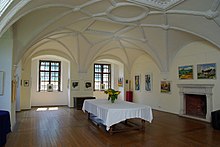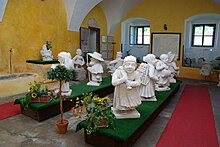Greillenstein Castle
| Greillenstein Castle | ||
|---|---|---|
|
Greillenstein Castle |
||
| Creation time : | around 1313 | |
| Conservation status: | Received or received substantial parts | |
| Place: | Greillenstein | |
| Geographical location | 48 ° 39 '30.9 " N , 15 ° 30' 52.1" E | |
|
|
||
Greillenstein Castle is a Renaissance castle in Greillenstein in the Lower Austrian municipality of Röhrenbach . The history of the castle is closely linked to the Kuefstein family.
history
In 1313 a small fortified castle is reported for the first time, which was owned by the Greillen family (also Grello ). Incidentally, this is the last point in time up to which the sex of the Greillen can be proven. The first documented mention of the castle dates from 1371, when it came into the possession of the Lords of Dachbeckh.
Until 1499 the estate was owned by the von Dachbeckh lords, later it belonged to the von Volkra lords. Since 1534 Greillenstein has been in the possession of the barons (later counts) von Kuefstein, whose most famous family member was the ambassador and later Vicedom (comparable to today's governor ) of Upper Austria Johann Ludwig von Kuefstein .
The rule Greillenstein was bought in 1534 by Baron Johann Lorenz von Kuefstein and his son Baron Hans Georg III. von Kuefstein had the old fortified castle demolished between 1570 and 1590 and, according to tradition, commissioned an Italian master builder to build today's Greillenstein Castle in its place, which was completed in 1604, including interior fittings and furnishings.
Greillenstein was built as the administrative seat for three large manors ( Feinfeld , Schauenstein and Greillenstein) in the Waldviertel and as a representative and summer residence for the family. This was necessary because the Kuefsteins were Protestant at the time and Hans Georg III, as Vicedom of Lower Austria, needed a place from where he could conduct his official business.
Despite the Protestant sentiments of the Kuefstein family, they always remained devoted to the emperor, but there were always armed conflicts with the neighboring Altenburg monastery .
In the Thirty Years' War Greillenstein was spared from devastation, but Hans Jacob Baron had left the castle in 1620, when it from the leader of the Kuefstein of the Catholic League , Elector Maximilian of Bavaria was occupied. Greillenstein was briefly the Catholic headquarters. Elector Maximilian, Count Tilly and Field Marshal Count Bucquoy met here before the Battle of White Mountain to work out a tactic for the upcoming war for several days. Shortly before the end of the Thirty Years' War, small Swedish troops passed by and occupied the castle without a fight, but without causing any damage. In 1623 Hans Jacob von Kuefstein converted to the Catholic faith and was able to save the rule for his family.
In 1634 the reign of Emperor Ferdinand II was granted high jurisdiction. The regional court , which is still in existence today, dates from this period with a considerable collection of medieval court files.
During the Fifth Coalition War in 1809 over 1,000 French soldiers and 1,400 horses were billeted. When these were withdrawn, the facility was so devastated and the financial basis of the rule so shattered that Johann Ferdinand III. Count Kuefstein Greillenstein offered the emperor to purchase, but the latter refused. By 1815 the debt could be reduced and the damage repaired.
After the dissolution of the manor in 1848, the castle lost its function as an official building. In the 19th century, artists like Franz Grillparzer , whose cousin was married to the local manager and who was inspired for his play The Ahnfrau , and Anton Romako , who was discovered and promoted by Countess Maria Magda von Kuefstein, stayed in Greillenstein.
The castle survived both the First World War and the Soviet occupation after the Second World War without damage. After 1945, a trained Soviet officer had the castle guarded so that there was no looting.
1945 after the end of the war Johann Ferdinand (IV) Kuefstein (* 1885 in Rome , † 1958 in Viehofen ) moved with his family to Greillenstein. In 1959 a museum was set up in the castle, the 60th anniversary of which was celebrated on June 20, 2019. His son Karl (II) Kuefstein (* 1923 at Castle Viehofen ; † 2014 in Greillenstein) moved with his family from the castle to an adjoining building in 1960 and founded the Friends and Patrons Association of Greillenstein Castle in 1992 .
The current (2019) owner family of the palace are Karl's son Andreas Kuefstein (* 1954 in Vienna) and his wife Elisabeth Kuefstein (* 1959 in Leutstetten ; ∞ 1986), born Princess of Bavaria. The Wittelsbacherin , daughter of Rasso Prince of Bavaria (1926–2011), is a great-granddaughter of Marie Valerie of Austria and thus a great-great-granddaughter through her mother Theresa Habsburg-Lothringen (* 1931 at Wallsee Castle ) and grandfather Theodor Salvator Habsburg-Lothringen from Empress Elisabeth .
Architecture and furnishings
Greillenstein Castle is a four-wing complex around a square inner courtyard, in which there are several baroque vases designed by Johann Bernhard Fischer von Erlach . Most of the interior furnishings are still in their original state and have been partially supplemented.
The building has two main floors. There is a large gate tower in the south. A bridge with baroque stone figures leads across the moat . In front of the castle is an English landscape garden that was laid out in the 17th and 18th centuries.
Between 1700 and 1720 the castle was equipped with a 47 hectare zoo, a baroque water play area with a water-spouting dragon sculpture and 24 dwarf figures as well as a new driveway. Hans Leopold Graf Kuefstein had the palace carefully redesigned in Baroque style in 1720. At that time it received its main entrance today in the central tower on the south side. Around 1770 the interior was partially renewed.
The chapel in the south tower has a uniform Renaissance interior from the time it was built, which is unique in the Waldviertel . The ballroom is in the west wing, the Turkish hall with portraits of Sultan Murad IV. In the north wing.
The furnishings of the large library from the 17th century have been partially preserved, with the coffered ceiling today in Laxenburg Castle , while the furnishings of the small library from the 16th century have been completely preserved. In the castle there are also chimneys and doors from the 16th century, stoves from the Rococo , paintings from the 17th century to the 19th century and other valuable exhibits.
In the first years of the 21st century the building was largely renovated.
Various farm buildings also date from the time the castle was built, some of which are still in use, others are in a ruinous condition.
Not far from the castle in Röhrenbach is the Kuefstein crypt chapel with a dome fresco by Paul Troger .
The castle including farm buildings and the castle park are under monument protection.
Museum and exhibitions
The building has been privately owned by the Kuefstein family since 1534 and has not been inhabited since the 1960s, but serves as a museum. It is one of the first castles to be opened to the public as a museum.
- In 1967, the Museum of Legal History was founded at Greillenstein Castle, which moved to Pöggstall Castle in 1988 . Part of this museum was the former regional court , which is still located here today , which has an extensive collection of mediaeval court files and which houses the only court barrier still preserved in Austria.
- Greillenstein Castle has a considerable collection of garden gnomes and a sandstone kite, which were created around 1700.
- Permanent exhibitions:
- The diplomatic relations between Habsburg emperors and the Ottoman Empire
- Grillparzer's visits to Greillenstein Castle
literature
- Castles, monasteries and chateaux regions Waldviertel, Danube region, South Bohemia, Vysočina, South Moravia ISBN 978-3-9502262-2-5 , p. 42 ff.
Web links
- Entry on Greillenstein in the scientific database " EBIDAT " of the European Castle Institute
- Entry about Greillenstein Castle in Lower Austria Castles online - Institute for Reality Studies of the Middle Ages and Early Modern Times, University of Salzburg
- Entry via Greillenstein Castle to Burgen-Austria
- Site of the Greillenstein Castle
- First-hand history - Greillenstein Castle
- Entry on Greillenstein Castle in the Austria Forum (in the Heimatlexikon)
- Entry for Schloss Greillenstein in the database of the state's memory for the history of the state of Lower Austria ( Museum Niederösterreich )
- Literature about Greillenstein in the Lower Austrian State Library
- Journal articles about Greillenstein in Lower Austria Bibliography of the Lower Austrian Institute for Regional Studies
- Pictures by Greillenstein in the topographical collection of the Lower Austrian regional library
Individual evidence
- ^ Studies on Family History Volume 2 by Karl Graf Kuefstein, KuK Geh.Rat, ao envoy and bev. Minister a. D., Vienna-Leipzig 1911, Wilhelm Braumüller Verlag, pp. 15ff and 79ff
- ^ University of Vienna / Diploma thesis by Beatrice Ludl from 2009, p. 67 (PDF; 3.8 MB)
- ↑ since 1414 owned by the Kuefstein family
- ↑ was bought in 1576 by Hans Georg II Baron von Kuefstein
- ↑ 383 officers of all ranks and 639 soldiers and domestics
- ↑ a b c Thomas Weikertschläger: 60th anniversary: History lives in Greillenstein Castle. The Museum Schloss Greillenstein celebrated its 60th anniversary. Roof renovation continues to need donations. In: NÖN.at , June 26, 2019, accessed on October 13, 2019.
- ↑ Note: Details on the history of Greillenstein Castle are based on a conversation with Elisabeth Kuefstein at the family castle on August 18, 2011 using documents from the castle library and partly contradict statements made in other sources (e.g. DEHIO).
- ↑ a b Thomas Jorda: Don't complain. Elisabeth Kuefstein at Greillenstein Castle in the Waldviertel: “I don't go through the wall with my head.” In: NOEN.at, November 27, 2011, accessed on October 13, 2019.
- ↑ See in: Family tree of the lords of the castle in Wallsee. ( Memento of March 4, 2016 in the Internet Archive ) (PDF; 87 kB) on the website of the Wallsee-Sindelburg community , undated. (Here: "Theresia / Ehgin [= Archduchess] v. Austria / Rasso Prinz v. / Bavaria".)
- ↑ Andreas Zbiral: The baroque gardens of Greillenstein Castle (PDF; 18 kB)
- ↑ The number has only survived and is not documented, but it can be regarded as probable, since accessories were usually made by the dozen at this time. The nine figures obtained represent simple people in everyday situations; they are now housed in the castle, cf. Andreas Zbiral: The baroque gardens of Greillenstein Castle (PDF; 18 kB)
- ↑ List of listed objects in Röhrenbach (Lower Austria)
- ↑ Folder of the lock management ( page can no longer be called up , search in web archives ) Info: The link was automatically marked as defective. Please check the link according to the instructions and then remove this notice.
- ↑ Greillenstein Web Museum






